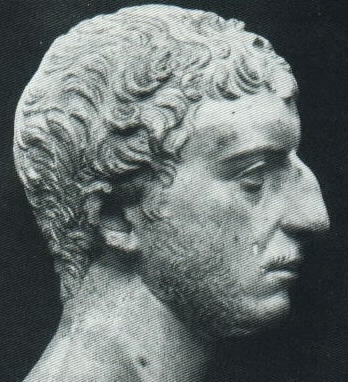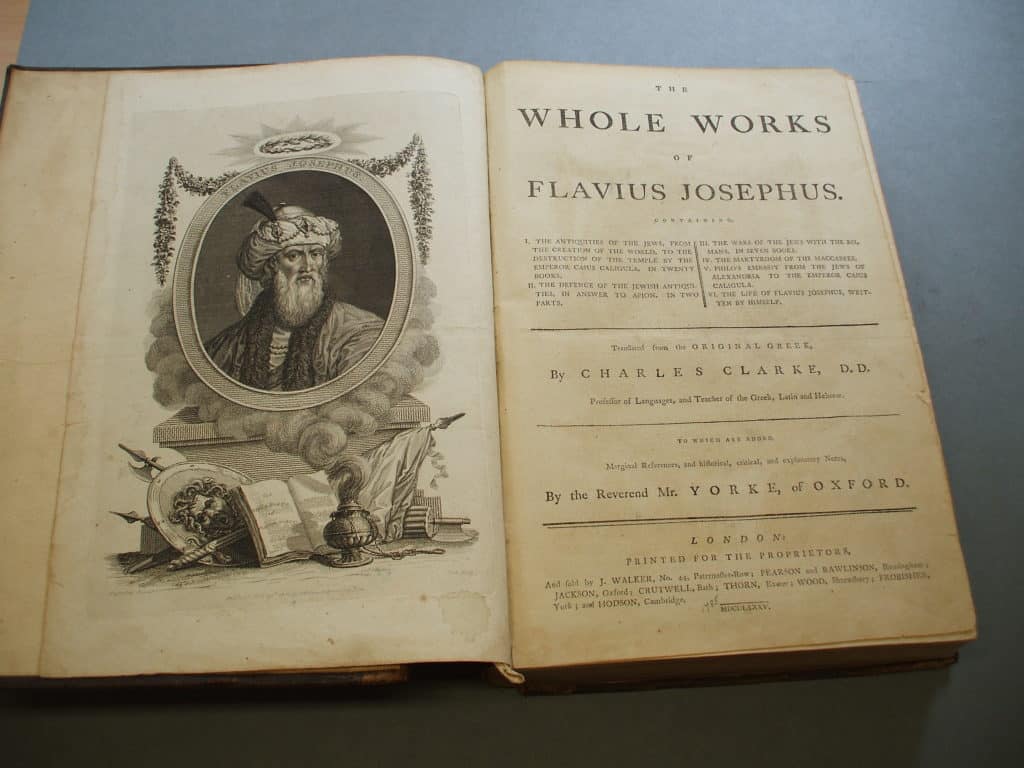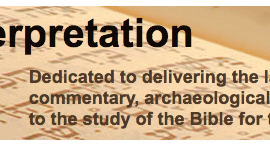The 1st century CE Jewish historian Titus Flavius Josephus, known today as Josephus, was born Yosef ben Matityahu /יוסף בן מתתיהו in the year 37 CE. He began his career as commander of the Jewish forces in the Galilee in the 1st Jewish Revolt against Rome in 66CE, subsequently surrendered to the Roman general Vespasian, and ended up living out his days in Rome as a patron of the new emperor and his sons Titus and Domitian. His three major works are The Jewish War (c. 75 CE), Antiquities of the Jews (94 CE), and Against Apion (97 CE), which is a defense of Judaism against Greek criticisms. He also wrote a short biography called Life of Flavius Josephus toward the end of his life. He died around the year 100 CE. He is unquestionably our most valuable historical source for students of ancient Judaism and emerging Christianity for the period. I tell my students who are interested in Christian Origins–first and foremost, read Josephus! [1]His complete works are readily available in print and on-line in the archaic 18th translation by the remarkable mathematician and theologian William Whiston (1667-1752), as well as the Loeb Classical … Continue reading

Of special interest to students of Christian origins are the short but invaluable descriptions Josephus gives us of John the Baptizer, Jesus, and James, the brother of Jesus. These three figures, all brutally murdered by the political and religious establishment, just happen to be the founding figures of what scholars call “the Jesus movement.” And yet, properly understood in its historical contexts, this Messianic movement is broader than Jesus, beginning with John the Baptist, and advancing significantly under the leadership of Jesus’ successor, his brother James. [2]Here see the pioneering work of Robert Eisler, Jesus the Messiah and John the Baptist and most recently, Robert Eisenman, James the Brother of Jesus. Eisler, whose 1929 German edition was translated … Continue reading It is noteworthy that in Josephus’s earlier work, The Jewish War, John, Jesus, or James go completely unmentioned. It is only decades later, in the 90s CE, when Josephus comes to write the Antiquities, that he includes this material. My own guess is that he is well aware that the emperor Vespasian, following the heat of the War in Judea, is very keen to suppress any movement that might be deemed “Messianic,” and particularly one built around the expectations of a Davidic ruler as rightful king of the Jews. Josephus is surely aware of the Nazarene movement, but he is not inclined to expose them to imperial scrutiny, and perhaps he even wants to shield them in that regard.
What he says about John the Baptizer and James the brother of Jesus, is truly precious material, coming as it does from an “outsider” with no Christian theological agenda. Josephus, of course, has his own multiple and tendentious purposes, but supporting any particular side of controversies about the place and role of John or James in the movement is not on his radar screen. I encourage readers to study carefully every line of these valuable passages. Notice in particular, Herod Antipas who has John killed was most concerned over John’s great influence over the populace and its potential for sparking a full scale revolt against Roman rule. He is also familiar with John’s rites of ritual immersion in water (“baptism”) as a sign of one repenting of sins and turning toward righteousness. James, likewise, has the favor of the people and his murdered by the High Priest Ananus, whom Josephus considers to be an insolent and arrogant ruler. For a full discussion of these passages, their subsequent history, and lots of bibliography, see here.

His “testimony” to Jesus is more problematic since it has been so heavily interpolated by medieval Christian copyists. However, we are more than fortunate that these pious scribes had such heavy hands, since their additions appear to be so blatant and obvious, in both placement and phrasing. Scholars have worked on this text quite extensively and I recommend the summary discussion by John Meier, A Marginal Jew: Rethinking the Historical Jesus (Doubleday, 1991), Vol I, pp. 57-88.
Taking the passage and striking through the obvious interpolations we end up with the following results:
Now there was about this time Jesus, a wise man
if it be lawful to call him a man, for he was a doer of wonders,a teacher of such men as receive the truth with pleasure. He drew many after him both of the Jews and the Gentiles.He was the Christ. When Pilate, at the suggestion of the principal men among us, had condemned him to the cross, those that loved him at the first did not forsake him,for he appeared to them alive again the third day, as the divine prophets had foretold these and ten thousand other wonderful things about him, and the tribe of Christians, so named from him, are not extinct at this day (Antiquities 18:63-64).
This bare and minimal account I find quite instructive. If one reads it again, without the additions, we have:
Now there was about this time Jesus, a wise man, for he was a doer of wonders. He drew many after him. When Pilate, at the suggestion of the principal men among us, had condemned him to the cross, those that loved him at the first did not forsake him, and the tribe of Christians, so named from him, are not extinct at this day (Antiquities 18:63-64).
The content of this short report is strikingly close to what critical historians would distill as a kind of bare minimum regarding the historical Jesus–a wise teacher and wonder-worker who ran into opposition from the religious and political authorities and was crucified, but whose movement continued after his death. That Josephus does not mention anything about Jesus being resurrected was what obviously most troubled the medieval Christian copyists.
Robert Eisler’s discussion of this controversial passage, an excerpt of which one can find here with helpful notes by Steve Mason, goes much further than removing these obvious Christian theological interpolations. Eisler suggests restoring certain deletions that he is convinced were once in the original, hence he comes up with the following:
Now about this time arose an occasion for new disturbances, a certain Jesus, a wizard of a man, if indeed he may be called a man who was the most monstrous of all men, whom his disciples call a son of God, as having done wonders such as no man hath ever yet done…He was in fact a teacher of astonishing tricks to such men as accept the abnormal with delight….And he seduced many also of the Greek nation and was regarded by them as the Messiah…And when, on the indictment of the principal men among us, Pilate had sentenced him to the cross, still those who before had admired him did not cease to rave. For it seemed to them that having been dead for three days, he had appeared to them alive again, as the divinely-inspired prophets had foretold — these and ten thousand other wonderful things — concerning him. And even now the race of those who are called “Messianists” after him is not extinct.
Steve Mason suggests, and I have to agree, that inserting deletions is infinitely more susceptible to speculation than removing obvious interpolative additions. Although Eisler provides his justification for this reconstruction it remains, so far as I can see, quite questionable.
Some years ago Professor Shlomo Pines found a different version of this passage in an Arabic version of Josephus dating to the tenth century CE. [3]The source is called Kitab al-‘Unwan written by Agapius of Manbij who lived in northern Syria. It is published by Shlomo Pines, An Arabic version of the Testimonium Flavianum and its … Continue reading It has obviously not been interpolated in the same way as the Christian version circulating in the West and it reads remarkably close to our “non-interpolated” version above:
At this time there was a wise man who was called Jesus, and his conduct was good, and he was known to be virtuous. And many people from among the Jews and the other nations became his disciples. Pilate condemned him to be crucified and to die. And those who had become his disciples did not abandon their loyalty to him. They reported that he had appeared to them three days after his crucifixion, and that he was alive. Accordingly they believed that he was the Messiah, concerning whom the Prophets have recounted wonders.
In my 2006 book, The Jesus Dynasty, I argue that the followers of John the Baptist, Jesus, and James the brother of Jesus, in contrast to those influenced by Paul, shaped their post-crucifixion hopes and future expectations on a decidedly apocalyptic Messianic vision that focused on the arrival of the Kingdom of God on earth and the fulfillment of the promises of the Hebrew Prophets (Isaiah 2:2-4; Zechariah 14; Isaiah 11; Micah 5:2-4; Jeremiah 30-31). Not surprisingly, what Josephus tells us about John the Baptizer, Jesus, and James fits hand-in-glove with what we understand from the Dead Sea Scrolls and other contemporary late 2nd Temple Jewish sources about the 1st century CE “messianic movement in Palestine,” as Robert Eisenman so aptly called it.









Comments are closed.